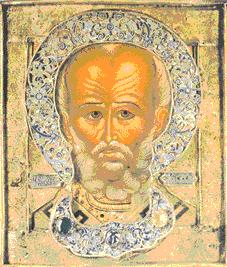St Nicholas the
Wonderworker
Commemorated December 6
 The
true greatness of this beloved Saint is hidden in the
shadows of legend, obscuring the identity of one of the most
endearing of our saints. The
true greatness of this beloved Saint is hidden in the
shadows of legend, obscuring the identity of one of the most
endearing of our saints.
Nothing is known of the early life of Nicholas, except
that he was born at the turn of the fourth century, during
the reign of the Emperor Diocletian, in Asia Minor and was a
Bishop of Myra, in that area which is now Turkey. Of
a quiet and and studious nature, he attended the Synod of
Nicaea in A.D. 325. On that momentous occasion he was so
withdrawn that he is not even mentioned in the account of
the proceedings recorded by St. Athanasios the Great;
however, his behind the scenes activity did add to the
luster of this memorable convocation. His importance was
recognised by the Emperor Justinian, who had a magnificent
cathedral erected in his memory in Constantinople.
Prior to his elevation as Archbishop, Nicholas had
suffered imprisonment, harsh treatment and torture at the
hands of the enemies of the Church. It was not until the
reign of the Christian Emperor Constantine that he was able
to lead the normal and peaceful life of a prelate. His
leadership in Myra, which did not offer very hospitable
surroundings for the Christians of the day, was so effective
that his fame and popularity gave rise to many legends that
were well intended but served only to screen the true
character of this very real and industrious saint who
laboured for Christ all the years of his life, echoing the
truth of Christianity uttered centuries before by the
apostles.
So great was St. Nicholas' popularity that he became the
symbol of protection of children, which led to many of the
legends about him. After his death by natural causes at a
venerable age, the legends and myths multiplied, but they
only demonstrate how dearly loved he was for his great work.
He became not only the patron saint of children, but also of
merchants, sailors, and scholars, and was a protective
symbol for travellers against highwaymen.
In a fascinating and daring enterprise in the late
eleventh century, the residents of Bari, Italy, where
Nicholas' popularity had grown with the years, hatched a
plot to recover the remains of the saint from Turkey.
Through guile and ruse they were able to outwit the unwary
but dangerous natives of Asia Minor and succeeded in
removing the body of Saint Nicholas and transporting it to
Bari. There it was paraded in triumph through the streets
before being properly enshrined on 9 May 1087, after which a
magnificent basilica was erected in his honour.
from Orthodox Saints, v. 4,
by Fr George Poulos, Orthodox Press
|